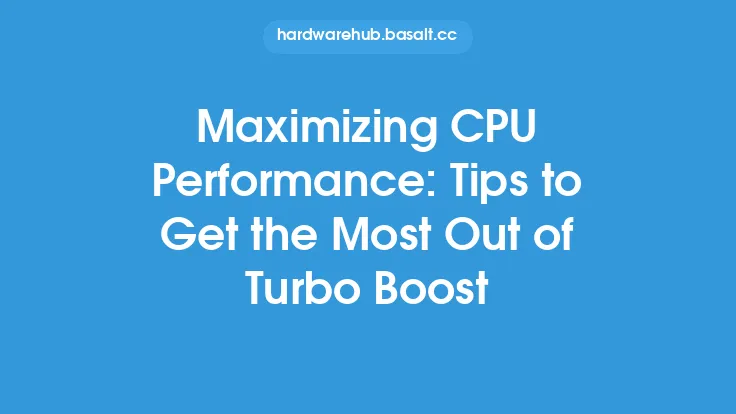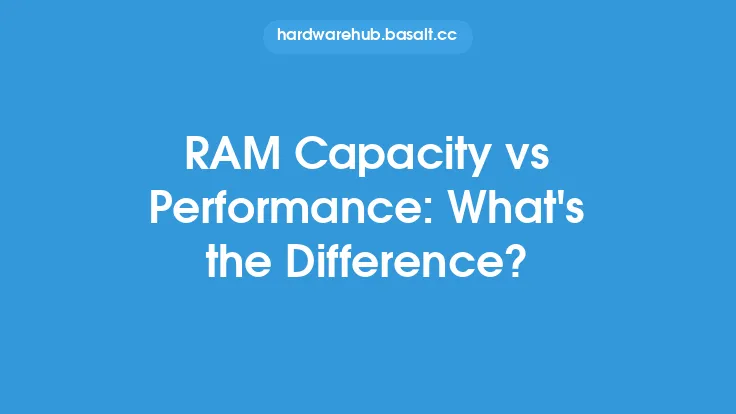When it comes to increasing the performance of a computer's central processing unit (CPU), two terms are often thrown around: CPU Turbo Boost and overclocking. While both methods aim to improve CPU performance, they operate in distinct ways, with different benefits and drawbacks. In this article, we'll delve into the differences between CPU Turbo Boost and overclocking, exploring how they work, their advantages and limitations, and what they mean for users.
Introduction to CPU Turbo Boost
CPU Turbo Boost is a technology developed by Intel that allows a processor to temporarily increase its clock speed above its base operating frequency. This boost in speed enables the CPU to handle demanding tasks more efficiently, resulting in improved performance and responsiveness. Turbo Boost is a dynamic feature, meaning it only kicks in when the system requires extra processing power, and it can be limited by factors such as power consumption, heat generation, and the number of active cores. The key aspect of Turbo Boost is that it's a built-in, automated feature that doesn't require user intervention to function.
Understanding Overclocking
Overclocking, on the other hand, is a manual process where the user deliberately increases the clock speed of the CPU beyond its factory-set limit. This is typically done to squeeze out extra performance from the processor, often for applications like gaming, video editing, or other compute-intensive tasks. Overclocking involves adjusting the CPU's clock multiplier or base clock rate, which can be done through the system's BIOS settings or specialized software. Unlike Turbo Boost, overclocking is a static process that requires user input and can potentially lead to system instability if not done correctly.
Key Differences Between Turbo Boost and Overclocking
The primary difference between CPU Turbo Boost and overclocking lies in their approach to increasing CPU performance. Turbo Boost is a dynamic, automated feature that temporarily boosts the CPU's clock speed, whereas overclocking is a manual, static process that permanently increases the clock speed until changed by the user. Another significant difference is the level of control and flexibility offered by each method. Turbo Boost operates within predefined limits set by the CPU manufacturer, ensuring that the system remains stable and within safe operating parameters. Overclocking, by contrast, allows users to push their CPU beyond these limits, which can lead to increased power consumption, heat generation, and potential system instability.
Technical Aspects and Limitations
From a technical standpoint, CPU Turbo Boost and overclocking have different limitations and constraints. Turbo Boost is limited by the CPU's power consumption, heat generation, and the number of active cores. When the system demands more processing power, Turbo Boost kicks in, increasing the clock speed until the CPU reaches its maximum power or thermal limit. Overclocking, on the other hand, is limited by the CPU's physical capabilities, such as its silicon design, cooling system, and power delivery. Aggressive overclocking can lead to increased power consumption, heat generation, and voltage requirements, which can reduce the CPU's lifespan or cause system crashes.
Real-World Implications and Considerations
In real-world scenarios, the choice between CPU Turbo Boost and overclocking depends on the user's specific needs and priorities. For most users, Turbo Boost provides a convenient, automated way to improve system performance without requiring manual intervention or expertise. Overclocking, however, is typically reserved for enthusiasts and power users who require extreme performance for specific applications. When considering overclocking, users must weigh the potential benefits against the increased risk of system instability, reduced CPU lifespan, and potential damage to the system.
Conclusion and Recommendations
In conclusion, CPU Turbo Boost and overclocking are two distinct methods for improving CPU performance, each with its advantages and limitations. While Turbo Boost offers a convenient, automated way to boost system performance, overclocking provides a more manual, flexible approach for enthusiasts and power users. When deciding between these two options, users should consider their specific needs, priorities, and level of expertise. For most users, Turbo Boost provides a reliable, hassle-free way to improve system performance, while overclocking is best suited for those who require extreme performance and are willing to accept the associated risks and challenges. By understanding the differences between CPU Turbo Boost and overclocking, users can make informed decisions about how to optimize their system's performance and get the most out of their CPU.





